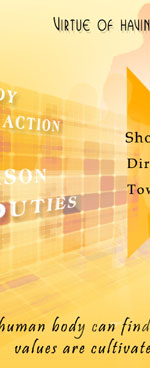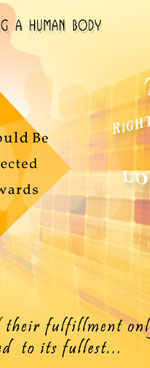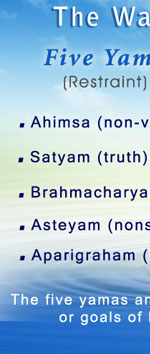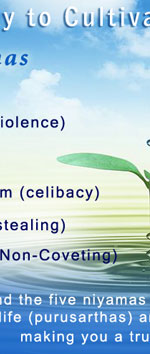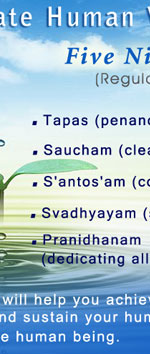CONVERSATIONS WITH SAI
Satyopanishad - Part 26
Direct Directions from the Divine
Dear Reader,
In response to your positive feedback to this section where we have a conversation with the Divine, we continue with Prof. Anil Kumar’s ‘Satyopanishad’ following Dr. John Hislop’s series ‘Conversations with Bhagavan Sri Sathya Sai Baba’ that ended in January 2008.
This series is also in the question-answer format that many devotees prefer, and has answers from Bhagavan on topics as wide ranging as the origin of evil, the goals of human life, and aspects of God – embodied and formless, to price hikes, women’s liberation, vegetarianism, and the generation gap among people of the present times.
Published in two parts by the author, these volumes have 270 questions in all, which are neatly grouped under separate chapters. In this issue, we continue chapter seven, “Sadhana, The Inner Door”.
CHAPTER VII:
Sadhana, The Inner Door
Prof. Anil Kumar: Swami! We have to work for our own moksha. But, how can we develop spiritually the basic human quality? Will spiritual awareness help us to be more human and ultimately experience the divine?
Bhagavan: Today, everyone appears to be a human being by virtue of having a human body. But, it is by virtue of your behaviour and nature that you should be a human being. You seem to have forgotten the value of human life. Kaya (the body), kala (time), karma (the action), kartavya (duties), and kaarana (the purpose of life) are all either misused or misdirected or wasted. Though there is considerable progress in science and technology, the basic human values are lost. Everywhere there is an atmosphere of fear, anxiety, tension, insecurity or agitation and restlessness.
To cultivate human values two qualities yama (restraint) and niyama (regulation) and the five principles ahimsa (non-violence), satyam (truth), asteyam (not coveting others' property), aparigraham (not accepting or expecting anything from anybody) and brahmacharyam (celibacy) are essential.
Ahimsa does not merely mean refraining from killing or hurting anybody. By our thought, word, or deed, no one should be hurt or pained. This is true ahimsa or non-violence. If you are harsh to anybody, it is violence. If you harbour evil thoughts towards anybody or cast bad looks on anyone, it is violence. Therefore, non-violence means not causing harm to anyone and not hurting anybody either by thought, word or deed.
Then, the second principle is satyam truth. In the ordinary sense, you think that truth is telling exactly what you see, hear, and know. This is worldly truth.
|
Even scientific laws are not constant. They change from time to time with new inventions, discoveries, observations and experiments. They may be called scientific truths, or material truths. Newspapers convey facts and not truth. Then what is truth? That which is permanent, eternal and changeless is satyam, truth. Truth is God. You should speak truth in an acceptable and pleasing way.
The third principle is asteyam; you shall not covet others' property. You shall not steal. Asteyam in the true sense means not entertaining any thought to own or possess others' property or that which doesn't belong to you.
God created the whole world and gave it to man to be happy and to utilise it freely. But, however, he gave it on one condition. "Oh Man! You do whatever you want, but be prepared to face the fruits of your actions. You cannot escape from the consequences of your actions. In full knowledge of this, from now, you can enjoy and do whatever you wish to in this world". |
The fourth one is aparigraha. Don't expect as well as accept anything from anybody. But, you can accept things from your parents, Guru and God. You should not bother or pester your parents with demands they cannot afford to meet. You should accept wisdom and grace from your preceptor. But from God you must accept anything He gives you. Therefore, you are not permitted to receive anything from anyone. You should not become rnagrasta (indebted to anybody). Give, but don't receive.
The fifth principle is brahmacharya, celibacy. Brahmacharya doesn't mean remaining unmarried. A brahmachari is one who treads the brahmamarga. Chariyuncuta (to tread the path) of Brahman is brahmachari or a celibate. Harmony in thought, word and deed is brahmacharya.
|
Then, there are five niyamas. They are tapas (penance), saucham (cleanliness), s'antos'am (contentment), svadhyayam (scriptural reading) and isvara pranidhanam, (dedicating all deeds to God).
Saucham includes both outer and inner cleanliness. It is not enough if you are clean outwardly, taking bath everyday and wearing ironed clothes. You should be clean inwardly also. Attachment and hatred usually pollute your mind. You should see that the mind is not polluted by these two evils. Therefore, both outer purity and inner purity are necessary.
The second niyama is tapas, penance. Tapa does not mean that you should run away from home leaving behind your property. Nor does it mean that you should break your family ties and go to a forest or stand upside down with your head on the ground and the legs up above. True penance means saying what you think and doing it accordingly. In other words, the three "H's - Head, Heart and Hand" should be integrated by thought, word and deed. Giving up bad thoughts and deeds is penance. Pining for God or yearning for God is penance. Filling your heart with sacred thoughts is penance.
The third niyama is s’antos'am. You are under the impression that by fulfilling your desires, you will be satisfied and happy. No, contentment lies in putting a ceiling on your desires. Too many desires make your life miserable. You may offer any number of objects and any amount of material to fire. It will burn them all to ashes. Fire never says "no" or "enough" at any time. Like that, desires also have no limit.
The fourth niyama is svadhyaya or study of the Holy Scriptures. You should read every day one Holy Scripture. This is called parayana, worshipfulreading of a religious book every day. This cleanses your mind to some extent.
|
The fifth one is isvara pranidhanam. God is in you in the form of your conscience. You should satisfy your conscience. This is the most important.
Thus the five yamas and the five niyamas will help you achieve the objectives or goals of life (purusarthas) and sustain your human values making you a true human being.
Bhagavan: It is remarked that of all the values of life satya, truth is the highest -Satyannasti paro dharmah. All have truth as the basis. God is truth. The entire creation came into existence from that truth and will ultimately merge in truth.
Satyamu nundiyee sarvambu srustinche
Satyamuna anage sarva srusti
Satya mahimaleni sthalamedi kanugonna
S’uddha sattvam idiye chudaraiya
(Telugu poem)
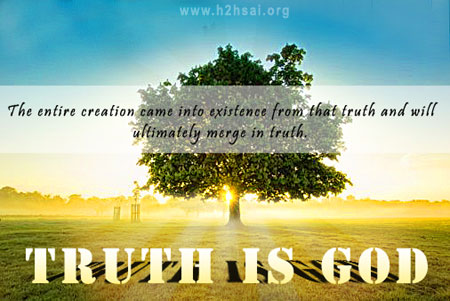 |
So, understand that God is truth and that truth is God. So, live in truth. Truth is the foundation of righteous conduct and the route to peace, which will make your life one of love.
Why is the history of Harischandra remembered till this day? Because he adhered to truth at any cost even sacrificing his wife, son and kingdom.
Those were the days when Prahlada was a king. One day he saw a resplendent lady leaving the palace. He asked her, "May I know who you are?" She replied, "I am your Character". Prahlada kept quiet.
Next day he saw another beautiful lady was coming out of the palace and when asked who she was, she replied, "I am your Kingdom - Rajyalakshmi ". He remained silent. Next day he saw another woman of matchless beauty coming out of the palace. He asked, "Mother! Would you let me know who you are?” She said, “I am your reputation, yasas.” He didn’t prevent her from leaving.
Next day he saw still another grand and majestic form, the like of whom he had never seen in his lifetime, coming out of the palace. He gently and reverentially asked her, “Mother! May I know who you are?” She replied, “I am Truth.” Then Prahlada fell at her feet and pleaded with her not to leave the palace. She finally agreed to get back into the palace and not to step out. Then what happened? The other angels, Character, Kingdom and Reputation followed her one after another back to the palace. It only means all will follow you if you have truth.
Prof. Anil Kumar: Swami! We do not have a precise idea of what dharma is and we are not able to conduct ourselves according to the little knowledge we have. Scholars expound dharma in a variety of ways: they designate one thing as dharma in one context and quite another in a different context. This adds to our confusion. Swami! Kindly explain dharma to us.
Bhagavan: What our elders and scholars had taught about dharma needs to be understood correctly. You should not hastily conclude that their views are contradictory.
Take for example the dictum, Satyannasti paro dharmah. What is to be chiefly noted here? The dictum means, ‘There is no dharma higher than satyam,’ and more too. The deeper meaning is, ‘the foundation of dharma is satyam.’ Now consider another dictum, ahimsa paramo dharmah. What does this mean? Earlier it is satyam which is said to be the foundation of dharma. Now, ahimsa, absence from violence, is called the highest dharma. Now ahimsa does not mean only refraining from violence.
Harming none through word, deed or thought is true ahimsa. |
Here, it is seen that satyam has been touched upon obliquely. Satyam knows neither fear nor wrath. Satyagraha is not just a compound word; where there is satyam, wrath does not exist. Satyam does not inflict pain. One who is rooted in satyam, cannot undertake violence. Rather he considers ahimsa as his dharma.
It is also said, vedokhilo dharmamulam. Veda which describes yajnas, yagas and other rituals treats their performance as dharma. It is our duty to perform the deeds enjoined on us by Veda. Here, you have to consider dharma from the perspective of duty. You have to perform your duty, fulfil your obligations. Therefore, it is said, kartavyam yoga muchyate.
Inthe verse from Gita, swadharme nidhanam sreyaha, paradharmo bhayavahaha, you have to realise that "swadharme" refers to atmadharma. Onthe other hand, the dharmas of the four castes and of the four stages of life are matters of birth. The population of the world is a mixture of black, white, yellow, and brown hues and these are to be found in all countries.
The dharmas of the four stages of life - brahmacharya, grahastya, vanaprastha, and sanyasa are to be viewed as four kinds of steps, four processes of sadhana to reach Brahman, after performing the deeds enjoined as one's duty. Thus, dharma is very subtle. The life force of satyam resides in utterance as does that of dharma in practice or action.
Prof. Anil Kumar: Swami! How does transformation of man come about?
Bhagavan: Actually transformation of man is transformation of mind. You wrongly tend to call it transformation of the heart. The heart is not the physical heart located in the left side of the chest. The spiritual heart is quite different and is all-pervasive. This is existence of awareness, and is not subject to change. Transformation of the mind is truly important, for only the one endowed with mind is to be called Man. An individual passes away, but his mind survives. That is why it is said,
mana eva manusyanam,
karanam bandhamoksayoh
The mind alone is the cause of bondage or release of men. When the mind reaches out, as it does in the Pravrttimarga, it gets saturated with desires, ideas, and worldly concerns. But when it is withdrawn in the nivrttimarga, all these are subdued. This state is called amanaskam (disinterestedness) and facilitates the experience of peace and joy. This is what is meant by transformation of the mind. Then alone is transformation of men possible.
|
Prof. Anil Kumar: Swami! How are we to comprehend the three fold path karmabhakti and jnana?
Bhagavan: You study your own wrist watches. Every watch has three hands the second, minute and hour, hasn't it? The second hand should go round sixty times for the minute hand to move one place.
Then the minute hand should go round sixty times for the hour hand to move to the next place. Here the second hand is karma marga- path of selfless action. The minute hand is bhakti marga - path of devotion, while the hour hand is jnana marga - path of wisdom.
I will give you another example. Most of you travel by train as you go home for vacation. You have three ways of reaching your destination. You can board a train- an express train that takes you to your place straight. You can also get into a train where the coach in which you are seated will be connected to another train at a railway junction.
It is a through-carriage and so you do not have to get down anywhere in between and change. Then there is another way. You catch a train and travel some distance, get down at a junction, and board another train to reach your place. This is a passenger train.
These three ways of journey hold good in the spiritual path as well. The path of selfless service (karma marga) is travel by a passenger train. The path of devotion (bhakti marga) istravel by a through-carriage where the carriage will be connected without your having to get down, to another train. Finally, the path of wisdom (jnana marga), isan express train that takes you straight to your destination.
Prof. Anil Kumar: Swami! It is said that we cannot escape from the consequences of our actions. It means we are responsible for both the good and the bad we experience. The fruits of our actions, thus, are inescapable. Then, how does devotion to God help us? Why should we be devoted to God at all?
Bhagavan: God created the whole world and gave it to man to be happy and to utilise it freely. But, however, he gave it on one condition. "Oh Man! You do whatever you want, but be prepared to face the fruits of your actions. You cannot escape from the consequences of your actions. In full knowledge of this, from now, you can enjoy and do whatever you wish to in this world".
So, for both good and bad, your actions are responsible. Then why should you be devoted to God? How does it help you? You may decide to raise onions or jasmines in your field according to your own liking, but you must pay the tax for utilising the land accordingly. Similarly the tax on the result of your actions is inescapable.
If you think you are an individual, jivi, the one others think you are or aham jivosmi, it yields the same meaning as in Jesus' statement, "I am the son of God," or the Persian declaration, "The light is in me" or chittakas'a, qualified non-dualism. But the final experience lies in knowing what you really are, aham brahmasmi, the same as what Christ said "I and My Father in Heaven are one" or the Persian declaration, "I am the light", or chidakas’a which is non-dualism. |
However you note one thing here. You pay income tax. You have to pay it proportionate to your income. There is no way out. But there is a provision for exemption. Be sure it is not definitely tax evasion. If you have paid some amount as premium to the Life Insurance Corporation, if you have paid some amount towards Provident Fund, you are eligible for some exemption out of the total tax payable by you. So, your taxable amount is reduced. Similarly, spiritual practices like daily prayer, service activity, meditation and worship help you to reduce the intensity and the magnitude of the consequences of your past actions which you face (karmaphala). They give you courage and forbearance needed to endure the suffering.
Bhagavan:
Atmavat sarvabutani,
eko vasi sarvabhutantaratma
Our scriptures say that God is only one without a second. He has manifested Himself as many according to His will: `Ekoham bahusyam,’ the one becoming many, everything is Divine. The plurality or multiplicity or diversity is due to name and form.
You will notice that` jnani,’ the one who inquires, ‘jneya’, the one to be known and ‘jnana’ knowledge are one and the same. This is called `triputi', trinity. Everything is out of that primordial principle of atma or consciousness.
 |
The gross body sthula, the subtle body sukshma, and the causal body karana, of everyone are out of the atma only. In the tamarind fruit, the outer green covering (is physical, gross, sthula), the middle soft pulp (is subtle body, sukshma), and the inner hard stone like seed (is astral body, karana).
All these are formed out of the original seed only. It is the seed that forms another seed in the times ahead. So, all the three are only atma.
I tell my students often, `You are not one, but three: the one you think you are (physical body), the one others think you are (individual mind), and the one you really are atma, conscience. You are born with a question, koham?
(Who am I?) If the reply is “Aham dehosmi, Iam the body”, it represents the first step, the one you think you are. To the same question koham, if the answer is “Aham, I am an individual, jiva’, it represents the second step, the one others think you are.
But to the question koham, if the answer is “Aham brahmasmi, Iam God”; it conveys the real truth, the third step, the one you really are. This is your real nature.
It is the same atma that exists in all the three stages, jagrata (waking), swapna (dreaming) and the shushupti (deep sleep). Atmavaisvanara (God who is the Atma) plays all the three roles. In the waking state it operates in association with the body, the mind and the intellect. Atma functioning in the waking state maybe called visva. Atmavaisvanara, functioning in a dream state, monitors the mind only. The entire thing is the creation of your mind only and the mind creates you when you pass through dream experiences. This atma of the dreaming state is known as taijasa.
The third stage of deep sleep shushupti also has the very same atma as in the previous two. In shushupti the body, mind and intellect do not exist. Atma remains as an experiencer called prajna. SoAtmavaisvanara left to itself is a pure, unsullied, unpolluted, eternal and immortal truth in the state of the ultimate turiya, expressed in the three levels of consciousness. In the waking state it is visva, in the dreaming state it is taijasa while in deep sleep state it is prajna.
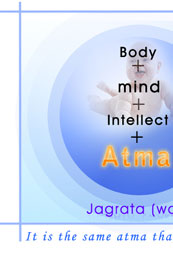 |
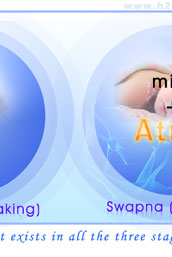 |
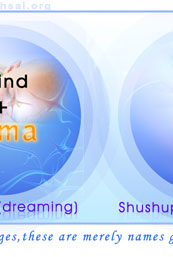 |
 |
These are merely names given to the same atma in these three states, just like an actor playing three different roles. For example, an actor by name Mallaya (equal to Atmavaisvanara, turiya state may play the role of Dharmaja in one scene, as that of visva in thewaking state, Arjuna in another scene, as that of taijasa in the dream state and Bhima in still another scene as that of prajna in deep sleep state, while Mallaya (atma) remains the same basically.
So in this universe everything is essentially atma. The five elements, the five senses of perception, the five senses of action, the five life breaths, the five life sheaths and the body constitute one wide area or realm called bhutakas'a. The impact, influence, and effects of all these components of the sphere of bhutakas'a (drawn from the outer world) are contained in or imprinted on a small sphere or field called chittakas’a, viz. the mind, chitta. But then there is atma which monitors and operates through the body, mind, intellect, the sense of ego (I ness) known as chidakas’a. These three are equivalent to the gross (sthula - bhutakas'a), the subtle (chittakas'a - sukshma) and the casual (chidakas’a - kaarana) forms.
This is what Christ also said in His first statement, "I am the messenger of God". This is dualism, dvaitha. The next statement of Jesus was, “I am the son of God.” This is qualified non-dualism (visishtadvaitha). Finally on the cross, Jesus said, "I and My Father in Heaven are one". This is non- dualism.
 |
 |
 |
 |
In the Persian language too it is first said, "I am in the light" which is the state of dvaitha, dualism.
Later it is said, "The light is in me", which is qualified visishtadvaitha, non-dualism and finally, it is stated, "I am the light", which is advaitha, non-dualism. We can find in all these states unity in diversity.
If you identify yourself with the body (aham dehosmi), it is the one you think you are or, what Jesus said, `I am the messenger of God' or it is bhutakas’a which is dualism, dvaitha.
If you think you are an individual, jivi, the one others think you are or aham jivosmi, it yields the same meaning as in Jesus' statement, "I am the son of God," or the Persian declaration, "The light is in me" or chittakas'a, qualified non-dualism. But the final experience lies in knowing what you really are, aham brahmasmi, the same as what Christ said "I and My Father in Heaven are one" or the Persian declaration, "I am the light", or chidakas’a which is non-dualism.
This is the only truth to be known and experienced. Hanuman said the same thing to Rama, "Oh Rama! If I think I am the body, I am Your servant; if I think I am an individual soul, jivi, You are my God, and if I think I am the atma You and I are one. This is the path of enquiry that leads to the discovery of one's true form, swaroopa.
Prof. Anil Kumar: Swami! God's creation is absolutely good. Then, from where do we get anything bad in life? When there is nothing bad in your creation how can there be bad actions at all? Or do you say that there are both good and bad in your creation? Kindly clarify this doubt.
Bhagavan: Creation is absolutely pure and good. There is no trace and scope for the bad to exist in God's creation. It is only the factor of time that makes you take things as good or bad. You eat today a phalam, good fruit. Tomorrow, the very same good fruit that you have eaten today transforms itself into malam, faeces. Is it not the same fruit? Is it not time that has brought about the change? Therefore, good and bad are present from your point of view. But to the Divine both are the same as He is non-dual.
 |
 |
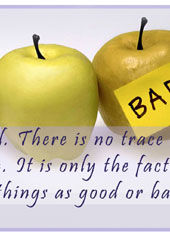 |
 |
God created everything for you to enjoy. It is in use that good and bad arise. For example, you brought all the necessary provisions from the market and kept them in the kitchen. It is now for you to cook properly with these provisions. The taste depends on the way you cook, how and in what proportions you mix the provisions: You have the needed utensils and the material. Now it is up to you to cook your food properly and make it a delicacy. Similarly, God has given you everything. Good and bad depend on the way you use the material given to you.
Prof. Anil Kumar: Swami! Pardon me for asking this question. At an advanced stage in our life when somehow our memory fades, we will not be able to remember all that we should. What is to be done?
Bhagavan: You are mistaken. Never say that your memory is fading. You say you are old. It is only an excuse, but it is not really so. You remember your date of birth, also exactly the date when you got married, when your children were born, when you performed their marriages, when your grandchildren were born, when you joined service and retired.
If what you say is correct, that you are losing your memory as you are aging, how do you remember these details then? It is only love for your family that makes you remember these dates. You have interest in these matters. Since you do not have such intense love and interest in spirituality, you take advantage of your advanced age as a lame excuse for complaining that your memory is fading. A fruit may be fully ripe, yet the seed within is hard.
Dear Reader, did this article inspire you in any way? Would you like more of such conversations with the Divine? Please share with us your reflections by writing to h2h@radiosai.org mentioning your name and country. Thank you for your time.



